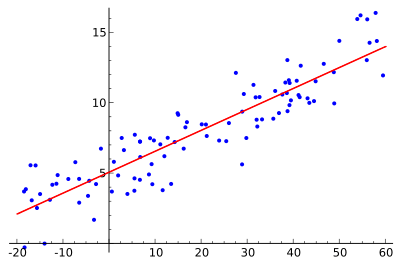Non-negative least squares
| Part of a series on Statistics |
| Regression analysis |
|---|
 |
| Models |
| Estimation |
| Background |
|
In mathematical optimization, the problem of non-negative least squares (NNLS) is a constrained version of the least squares problem where the coefficients are not allowed to become negative. That is, given a matrix A and a (column) vector of response variables y, the goal is to find[1]
- subject to x ≥ 0.
Here, x ≥ 0 means that each component of the vector x should be non-negative and ‖·‖₂ denotes the Euclidean norm.
Non-negative least squares problems turn up as subproblems in matrix decomposition, e.g. in algorithms for PARAFAC[2] and non-negative matrix/tensor factorization.[3][4] The latter can be considered a generalization of NNLS.[1]
Another generalization of NNLS is bounded-variable least squares (BVLS), with simultaneous upper and lower bounds αᵢ ≤ xᵢ ≤ βᵢ.[5]:291[6]
Quadratic programming version
The NNLS problem is equivalent to a quadratic programming problem
- ,
where Q = AᵀA and c = −Aᵀ y. This problem is convex as Q is positive semidefinite and the non-negativity constraints form a convex feasible set.[7]
Algorithms
The first widely used algorithm for solving this problem is an active set method published by Lawson and Hanson in their 1974 book Solving Least Squares Problems.[5]:291 In pseudocode, this algorithm looks as follows:[1][2]
- Inputs:
- a real-valued matrix A of dimension m × n
- a real-valued vector y of dimension m
- a real value t, the tolerance for the stopping criterion
- Initialize:
- Set P = ∅
- Set R = {1, ..., n}
- Set x to an all-zero vector of dimension n
- Set w = Aᵀ(y − Ax)
- Main loop: while R ≠ ∅ and max(w) > t,
- Let j in R be the index of max(w) in w
- Add j to P
- Remove j from R
- Let AP be A restricted to the variables included in P
- Let s be vector of same length as x. Let sP denote the sub-vector with indexes from P, and let sR denote the sub-vector with indexes from R.
- Set sP = ((AP)ᵀ AP)−1 (AP)ᵀy
- Set sR to zero
- While min(sP) ≤ 0:
- Let α = min(xi/xi - si) for i in P where si ≤ 0
- Set x to x + α(s - x)
- Move to R all indices j in P such that xj = 0
- Set sP = ((AP)ᵀ AP)−1 (AP)ᵀy
- Set sR to zero
- Set x to s
- Set w to Aᵀ(y − Ax)
This algorithm takes a finite number of steps to reach a solution and smoothly improves its candidate solution as it goes (so it can find good approximate solutions when cut off at a reasonable number of iterations), but is very slow in practice, owing largely to the computation of the pseudoinverse ((Aᴾ)ᵀ Aᴾ)⁻¹.[1] Variants of this algorithm are available in Matlab as the routine lsqnonneg[1] and in SciPy as optimize.nnls.[8]
Many improved algorithms have been suggested since 1974.[1] Fast NNLS (FNNLS) is an optimized version of the Lawson—Hanson algorithm.[2] Other algorithms include variants of Landweber's gradient descent method[9] and coordinate-wise optimization based on the quadratic programming problem above.[7]
See also
References
- 1 2 3 4 5 6 Chen, Donghui; Plemmons, Robert J. (2009). Nonnegativity constraints in numerical analysis. Symposium on the Birth of Numerical Analysis. CiteSeerX 10.1.1.157.9203
 .
. - 1 2 3 Bro, Rasmus; De Jong, Sijmen (1997). "A fast non-negativity-constrained least squares algorithm". Journal of Chemometrics. 11 (5): 393. doi:10.1002/(SICI)1099-128X(199709/10)11:5<393::AID-CEM483>3.0.CO;2-L.
- ↑ Lin, Chih-Jen (2007). "Projected Gradient Methods for Nonnegative Matrix Factorization" (PDF). Neural Computation. 19 (10): 2756–2779. doi:10.1162/neco.2007.19.10.2756. PMID 17716011.
- ↑ Boutsidis, Christos; Drineas, Petros (2009). "Random projections for the nonnegative least-squares problem". Linear Algebra and its Applications. 431 (5–7): 760–771. doi:10.1016/j.laa.2009.03.026.
- 1 2 Lawson, Charles L.; Hanson, Richard J. (1995). Solving Least Squares Problems. SIAM.
- ↑ Stark, Philip B.; Parker, Robert L. (1995). "Bounded-variable least-squares: an algorithm and applications" (PDF). Computational Statistics. 10: 129–129.
- 1 2 Franc, Vojtěch; Hlaváč, Václav; Navara, Mirko (2005). "Computer Analysis of Images and Patterns". Lecture Notes in Computer Science. 3691: 407. doi:10.1007/11556121_50. ISBN 978-3-540-28969-2.
|chapter=ignored (help) - ↑ "scipy.optimize.nnls". SciPy v0.13.0 Reference Guide. Retrieved 25 January 2014.
- ↑ Johansson, B. R.; Elfving, T.; Kozlov, V.; Censor, Y.; Forssén, P. E.; Granlund, G. S. (2006). "The application of an oblique-projected Landweber method to a model of supervised learning". Mathematical and Computer Modelling. 43 (7–8): 892. doi:10.1016/j.mcm.2005.12.010.